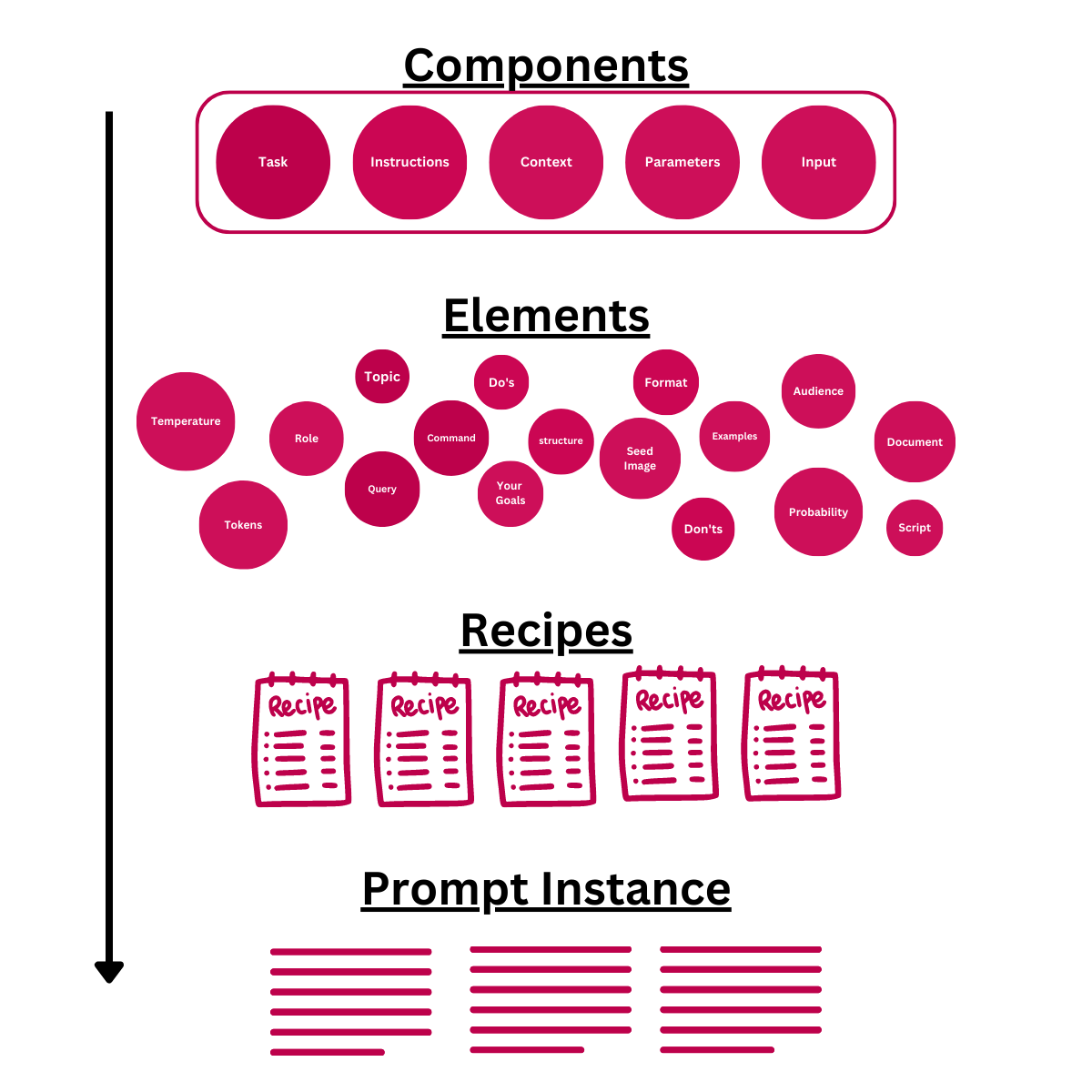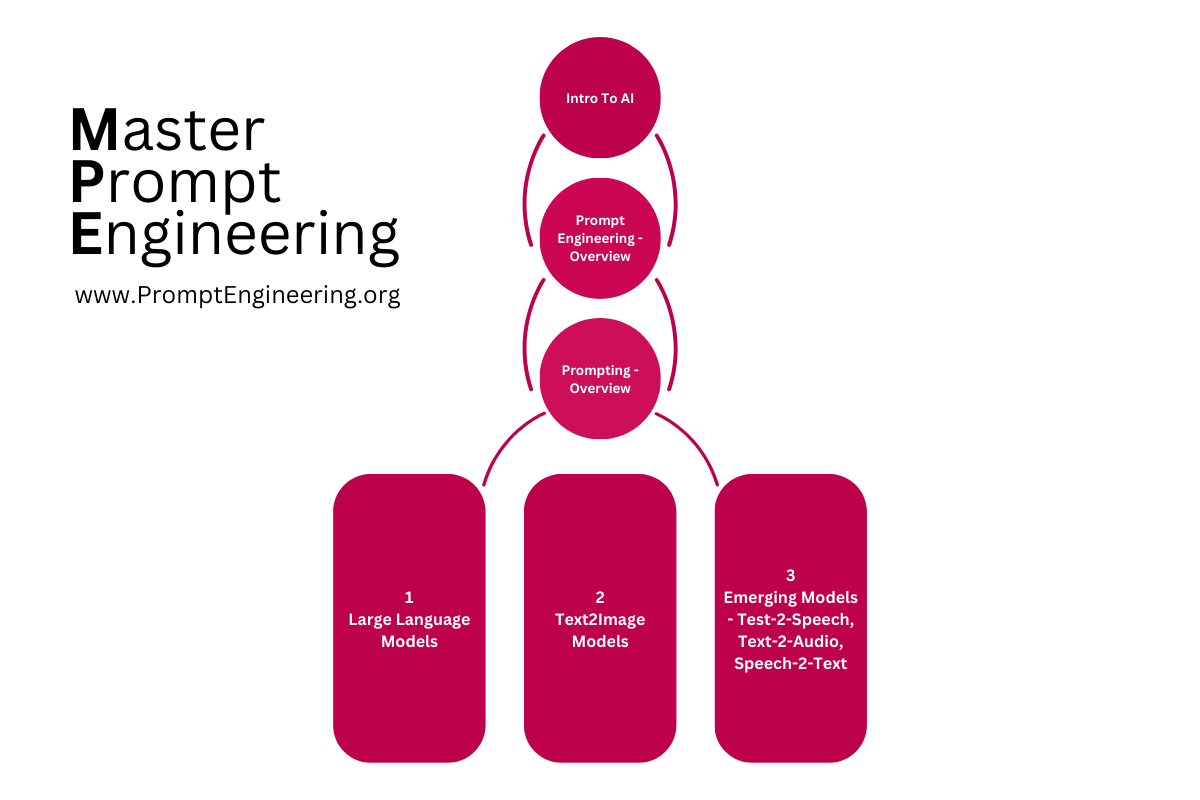Required Pre-reading

In this lesson we look at the importance of prompts in AI content creation. I explain what AI prompts are and how they work, and highlights the various forms that prompts can take. The lesson also covers the importance of effective prompts in shaping the user experience and determining the usefulness of an AI system.
Here I will also provide a hierarchical view of the structure of a prompt, starting with the general AI prompt components layer, followed by the element layer, and finally the recipe layer. The four key components of a great prompt are discussed in detail, including the task, instructions, context, and parameters/settings.
By understanding the structure and components of a prompt, you can craft effective prompts that will help you get the most out of your AI interactions. The lesson concludes by inviting you to dive into the world of prompting and create amazing AI interactions.
The Importance of Prompts in AI Content Creation
Artificial Intelligence (AI) has revolutionized the way content is created, but the quality of the output is dependent on the quality of the prompt. A well-designed prompt can steer the AI model towards producing engaging, relevant and on-point content, whereas a poorly designed prompt will result in generic and lackluster output.
Recently, the popularity of ChatGPT has brought attention to the field of Prompt Engineering, leading many to believe that “AI Prompts” only refer to the chat-style method used in ChatGPT.
However, this couldn't be further from the truth. An AI prompt can take many forms, including natural language prompts, image prompts, or even audio prompts. Essentially, anything fed to an AI model from which it must produce output is technically a prompt.
Prompts and prompting are critical aspects of AI content creation as they set the tone, style, and direction of the output. The prompt acts as a guide, shaping the final outcome and determining the success of the project.
In essence, the prompt acts as the paintbrush to the AI model's canvas. A skilled prompt engineer can turn a blank canvas into a masterpiece, just as a well-crafted prompt can transform an average AI-generated output into a compelling and persuasive composition.
What are “Prompts” and How Do They Work?
An AI prompt is a piece of text or information that serves as an instruction or command for the AI model. Whether we're asking a question, providing input, or directing the AI system to perform a specific task, a prompt is the key that allows us to communicate our intentions to the machine.
The prompt is the main means of communication between the user and the AI model, and its structure and content are critical to the success of the model in performing the desired task.
It's important to note that there are different types of AI models, each trained to specialize in specific types of input and output. This highlights the importance of understanding the different types of AI models and the unique prompting skills required to produce the desired output.
For instance, in the case of generative AI models, such as image generation models and large language models (LLMs), the prompt provides the model with the information it needs to generate a response. For image generation models, the prompt is typically a description of the image to be generated, while for LLMs, it can range from a simple question to a complex problem with multiple data inputs.
Here are some of the more popular AI Models:
- GPT-3 (Generative Pre-trained Transformer, Version 3): This model is trained to understand human language and is the model behind DALL-E 2 and ChatGPT.
- Codex: This model specializes in understanding computer code and can translate human language into computer code.
- Stable Diffusion is a deep learning, text-to-image model that is capable of generating detailed images based on text descriptions. It is a latent diffusion model, a type of deep generative neural network.
How Prompts Work
Good prompts provide clear and concise input to the AI system, which then generates a corresponding output. The prompt acts as a guide or request, directing the AI system towards the desired outcome. The nature of the prompt can vary depending on the type of AI system and the task it's being used for.
For instance, in the case of a language model like GPT, the prompt might be a simple sentence fragment that the model is asked to complete. The AI system will then analyze the input, draw from its vast database of knowledge, and generate a continuation of the sentence that's most likely to align with the given context and meaning. (Well so it seems, but in essence the AI is just guessing what the next word might be based on the previous chain of words).
In another example, the prompt might be a set of instructions or parameters for an AI system used for image or video processing. The AI system will use these prompts to adjust its behavior and perform the desired task, such as recognizing objects in an image or detecting specific events in a video.
The Many Forms of Prompts
AI prompts have evolved significantly over the years, with advances in language model and artificial intelligence technology leading to the development of more sophisticated and nuanced prompts.
In the early days of language model and AI, prompts were relatively simple, usually in the form of questions or basic commands. However, with the introduction of second and third-generation language models and text-to-image AI models, there has been a shift towards more thoughtful and meaningful prompts.
While AI prompts can take many different forms, ranging from simple text inputs to complex text and image prompts, the most effective prompts are those that are well-designed and tailored to the specific task and desired outcome.
With the increasing capabilities of AI models, it is becoming increasingly important for prompt designers to consider the nuances and complexities of the task at hand and to design prompts that effectively communicate the task and provide the necessary information to the AI model.
Who knows what prompts may entail in the future, they could be spoken word or even body language. The important thing to note is that the prompt provides the AI system with the information it needs to understand our request or command and generate an appropriate response.
What Makes a Great Prompt
As AI technology continues to advance, many commercial AI systems are now capable of producing usable and decent output with pre-programmed and trained models. However, to truly stand out from the competition and deliver exceptional results, it's important to aim for not just a good prompt, but a great one.
A good AI prompt is one that meets the user's intent and requires minimal post-processing and review. But a great AI prompt goes beyond this by not only satisfying the user's intent, but also exceeding their expectations. It opens up new possibilities and inspires the user to create unique and personalised content. Additionally, a great AI prompt requires little or virtually no post-processing, making the output more efficient and effective.
General Structure of a Prompt
If you want to make the most of your AI interactions, it's essential to understand the structure of a prompt.
The structure that I am about to present is a hierarchical one, and starts at a very general high level view showing the basic building blocks of any AI prompt. This is the top with component layer, a 30, 000 ft, generalized view of the prompt structure. This layer provides a foundation where we can build any type of prompt for any AI system.

Next, the element layer, these are blocks that make up the components in the component layer. These elements are the building blocks of the prompt and help to define the task and provide the necessary information to the artificial intelligence (AI) model. Use these blocks to build your prompt recipes by specifying what information is needed. While the component layer offered us a very wide and general scope applicable to almost any AI model, the element layer is very specific to the AI model and platform you are using.
The next layer , the recipe layer, are specific combinations various elements or sub components of the AI prompt in a specific order to achieve a desired outcome. In this layer the various elements of the component layer are combined and ordered in a way that defines the task and provides the necessary information to the AI model. The order in which these elements are combined can greatly impact the outcome of the task, and it is important to consider the desired outcome when designing the recipe layer.
The prompt layer is where the AI prompt comes to life, and it is the result of the careful design and consideration of the previous layers. In the prompt layer, the prompt recipes created in the previous layer are combined with real-world data and objectives to create a prompt that is tailored to the specific task and desired outcome.
Next we will end this lesson with a closer look at the component layer!
AI Prompt Components Layer
This is layer can be seen as an abstraction layer. It is only intended give a generalization and framework foundation to the underlying AI model, and present a universal understanding of virtually any AI prompt.
Some aspects maybe implied, such as in image generation models where the task is to create an image, but in LLM the task this maybe left up to the user to explicitly state. It is important to note, depending on the underlying AI Model, the order of elements may affect the output. This is precisely why we want would want to use such a model for a prompt.
Here's a closer look at the four components that make up a great prompt:
Task
The task refers to the specific action or process that an artificial intelligence (AI) model is trained to perform in response to a prompt. It is the simplest form of a prompt. The task is the goal that you are directing the AI model to achieve. The task could range from answering a question to generating creative content, generating and image or writing a story or composing music (coming soon). As mentioned, tasks maybe implied by the model and not necessarily needed to be stated.
Action Point: Think of the task as the output + topic. Ex "write a social post on entrepreneurship"
Instructions
Beyond the task, you need to give the AI system specific instructions to achieve the desired outcome. These can be simple or complex, and may cover the overall interaction, the attributes and qualities of the output, and even the format of the output.
Instructions provide the AI model with a clear road map of what it needs to do, and they help ensure that the task is completed correctly and efficiently. Instructions can encompass the content you want the AI to include or build upon, as well as any do's and don'ts. And the specific steps or actions that must be taken to complete the task.
For example, if the task is to write a poem, the instructions could specify the length, rhyme scheme, and meter of the poem.
Context
While instructions are specific steps or actions, or attributes of the output, that must be taken to complete the task, context refers to the background information or situation that surrounds a task. It provides the AI model with additional information about the task and helps it understands the situation and the goals of the task. The context maybe seen as guides and not strict rules
The context sets the stage for the AI system and provides information that helps it understands what you're after. This can come in the form of examples, images, or seeds that give the AI a better idea of the response you expect.
Parameters/Settings:
These are specific elements or variables, that are either included in the prompt itself or set beforehand, that governs or directly affect the output of the AI model. These are usually meta-attributes or settings that likely cannot be set in plain language in the prompt.
Parameters can range from simple temperature and probability settings to more complex configurations specific to each AI model. Keep in mind that the available parameters and settings can vary greatly between AI systems, so it's important to familiarize yourself with what's available and experiment to find the right combination to meet your needs. In some AI models the parameters maybe used to define set instructions such “--no” parameter in MidJourney.
Input
This is particularly important when the is specific subject matter for transformation. Inputs may or may not be required for the intended output. Input can include images for editing or to build on such as for “inpainting” and “outpainting”, for instance, in generative art and diffusion models, or it can be various amounts of text or text files in the case of LLM.
Example Prompts
Before I bid you farewell and close this lesson off, it would not be fair to write a whole diatribe about prompts and not include a couple examples. So here are a few, first stated and then broken down to illustrate the pieces. In these examples the parameters are ignored for simplicity (trust me).
GPT/ChatGPT Prompt Example 1
Use the following idea to write a motivational article about mindfulness for entrepreneurs. Emphasize the importance of mental clarity and inner peace for success in business. Here is the idea: entrepreneurs is about serving.
Task: Use the following ideas to write a motivational article about mindfulness for entrepreneurs.
Instructions: Emphasize the importance of mental clarity and inner peace for success in business.
Context: Write to an audience of aspiring and established entrepreneurs.
Input: entrepreneurship is about serving
GPT/ChatGPT Prompt Example 2
Create a list of practical tips for aspiring entrepreneurs using the following quote. Emphasize the importance of serving others and making a positive impact. Write to an audience of struggling millennial who are interested in starting a business. Here is the quote: Turn your passion into a successful business by always putting the needs of others first.
Task: Create a list of practical tips for aspiring entrepreneurs.
Instructions: Emphasize the importance of serving others and making a positive impact.
Context: Write to an audience of struggling millennial who are interested in starting a business.
Input: Turn your passion into a successful business by always putting the needs of others first.
GPT/ChatGPT Prompt Example 3
Create Google Sheets formulae which copies all rows from sheet1 where column “A” contains word “iPhone”
Task: Create Google Sheet formula
Instructions: copies all rows from sheet1 where column “A” contains word “iPhone”
Context: Not applicable in this prompt
Input: Not applicable in this prompt
GPT/ChatGPT Prompt Example 4
Brainstorm novel ideas for an article on AI Prompt Engineering - the job of the future. Exciting, optimistic, hopeful tone. Potential objectives for this post could be to:
- Open people’s eyes by proving the status quo wrong.
- Share a solution to a tough problem.
- Distill an overwhelming topic into something approachable.
- Tell a suspenseful and emotional story that imparts a lesson.
- Articulate something everyone’s thinking about but no one is saying. Cut through the noise.
- Identify key trends on a topic.
- Then use them to predict the future.
- Contribute original insights to a field through research and experimentation.
Task: Brainstorm novel ideas for an article on AI Prompt Engineering - the job of the future.
Instructions: Exciting, optimistic, hopeful tone.
Context: Potential objectives for this post could be to:
- Open people’s eyes by proving the status quo wrong.
- Share a solution to a tough problem.
- Distill an overwhelming topic into something approachable.
- Tell a suspenseful and emotional story that imparts a lesson.
- Articulate something everyone’s thinking about but no one is saying. Cut through the noise.
- Identify key trends on a topic.
- Then use them to predict the future.
- Contribute original insights to a field through research and experimentation.
Input: Not applicable in this prompt
GPT/ChatGPT Prompt Example 5
Write a blog article on Sustainable living in the 21st Century. The article should be at least 2500 words. Each point should be clearly stated with headers and points must flow logically. The article should be written in a friendly, inspiring, using natural language and a conversational tone. Mention the use of alternative energy and nuclear energy. Do not use jargon. Do not use overly technical terms. Write from the perspective of an environmentalist. This article will publish in Readers Digest The article's audience is liberal moms. Write for the brand archetype The Lover: Forms sensual, spiritual, and companionable relationships, and creates intimate moments for their audience. Writing should be passionate, sensual, and intimate. Use emotive language that promotes romance, desire, and emotional connection.
Task: Write a blog article on Sustainable living in the 21st Century.
Instructions: The article should be at least 2500 words. Each point should be clearly stated with headers and points must flow logically. The article should be written in a friendly, inspiring, use natural language and a conversational tone. Mention the use of alternative energy and nuclear energy. Do not use jargon. Do not use overly technical terms.
Context: Write from the perspective of an environmentalist. This article will publish on Readers Digest The article's audience is liberal moms. Write for the brand archetype The Lover: Forms sensual, spiritual, and companionable relationships, and creates intimate moments for their audience. Writing should be passionate, sensual, and intimate. Use emotive language that promotes romance, desire, and emotional connection.
Input: Not applicable in this prompt
MidJourney Prompt Example 6
The primordial darkness embodying a Greek god, Erebus wearing ancient Greek clothing, galaxy with solar system as background, [cinematic, soft studio lighting, backlighting, dark background] --ar 2:3 --upbeta --q 2 --v 4
Task: Create an image (implied)
Instructions: cinematic, soft studio lighting, backlighting, dark background
Context: The primordial darkness embodying a Greek god, Erebus wearing ancient Greek clothing, galaxy with solar system as background,
Parameters: --ar 2:3 --upbeta --q 2 --v 4
By keeping these key elements in mind, you can craft effective prompts that will help you get the most out of your AI interactions.
What's Next?
This is where general Prompt Engineering ends and you must now choose your path. Do you want to move forward with the study of Prompt Engineering for Large Language Models - GPT-3, ChatGPT, Ai21 or do you want to learn more about text-2-image models such as MidJourney or Stable Diffusion?

Ready to dive into the world of prompting and create some amazing AI interactions!
Next Lesson In This Series
In the Prompt Engineering - Prompting series I will get into the actual art and science of constructing prompts using a well-defined and successful framework that has earned us combined over $2M. I show you how to use this framework to brainstorm, test and construct prompts for complex output, deconstruct popular prompts and customize them as well as provide templates that you can make your own. Subscribe and Stay Tuned

The Course Overview

Frequently Asked Questions
What are AI Prompts?
An AI prompt is a piece of text, image, or audio information that serves as an instruction or command for an AI model. It is the main means of communication between the user and the AI model, and its structure and content are critical to the success of the model in performing the desired task.
What are the different types of AI Prompts?
AI prompts can take many different forms, including natural language prompts, image prompts, or audio prompts. Anything fed to an AI model from which it must produce output is technically a prompt.
What is the importance of prompts in AI content creation?
The quality of the output from AI content creation depends on the quality of the prompt. A well-designed prompt can steer the AI model towards producing engaging, relevant, and on-point content, whereas a poorly designed prompt will result in generic and lackluster output. Prompts and prompting are critical aspects of AI content creation as they set the tone, style, and direction of the output.
What are the components of a great prompt?
The four key components of a great prompt are the task, instructions, context, and parameters/settings. The task refers to the specific action or process that an AI model is trained to perform. Instructions provide the AI model with a clear road map of what it needs to do, while context sets the stage for the AI system and provides information that helps it understand what you're after. Parameters/settings are specific elements or variables that govern or directly affect the output of the AI model.
What is the general structure of a prompt?
The structure of a prompt is a hierarchical one, starting with the general AI prompt components layer, followed by the element layer, and finally the recipe layer. The prompt layer is where the AI prompt comes to life, and it is the result of the careful design and consideration of the previous layers.
What is the AI Prompt Components Layer?
The AI Prompt Components Layer is a generalization and framework foundation of the underlying AI model, presenting a universal understanding of virtually any AI prompt. It provides a foundation where we can build any type of prompt for any AI system.
What is the role of instructions in a prompt?
Instructions provide the AI model with a clear road map of what it needs to do, and they help ensure that the task is completed correctly and efficiently. Instructions can encompass the content you want the AI to include or build upon, as well as any specific steps or actions that must be taken to complete the task.
What is the role of context in a prompt?
Context refers to the background information or situation that surrounds a task. It provides the AI model with additional information about the task and helps it understand the situation and the goals of the task. The context sets the stage for the AI system and provides information that helps it understand what you're after.
What are parameters/settings in a prompt?
Parameters/settings are specific elements or variables that are either included in the prompt itself or set beforehand, that govern or directly affect the output of the AI model. These are usually meta-attributes or settings that likely cannot be set in plain language in the prompt.
What is the role of input in a prompt?
Input is particularly important when there is a specific subject matter for transformation. Input can include images for editing or building on, or various amounts of text or text files in the case of language models. Input may or may not be required for the intended output.








